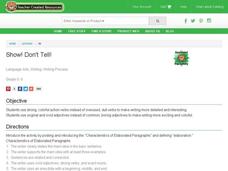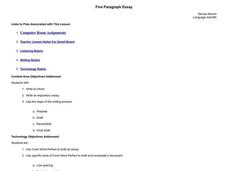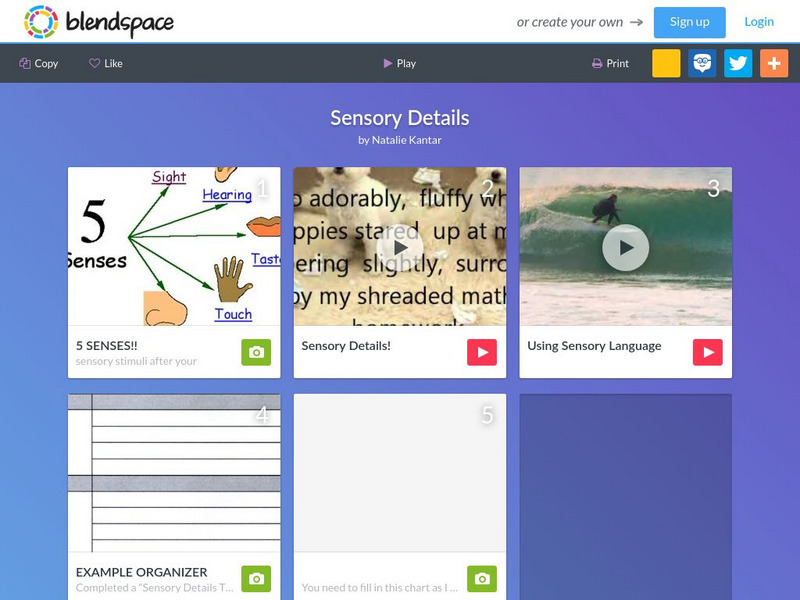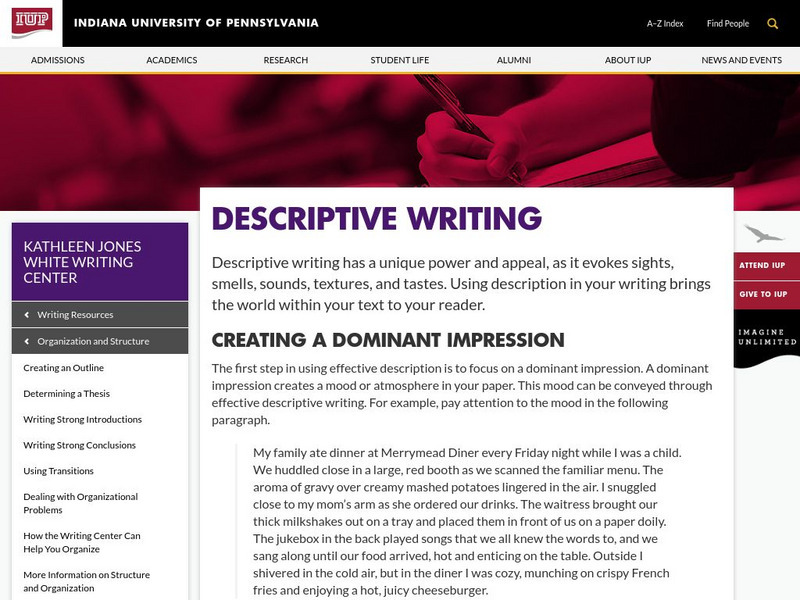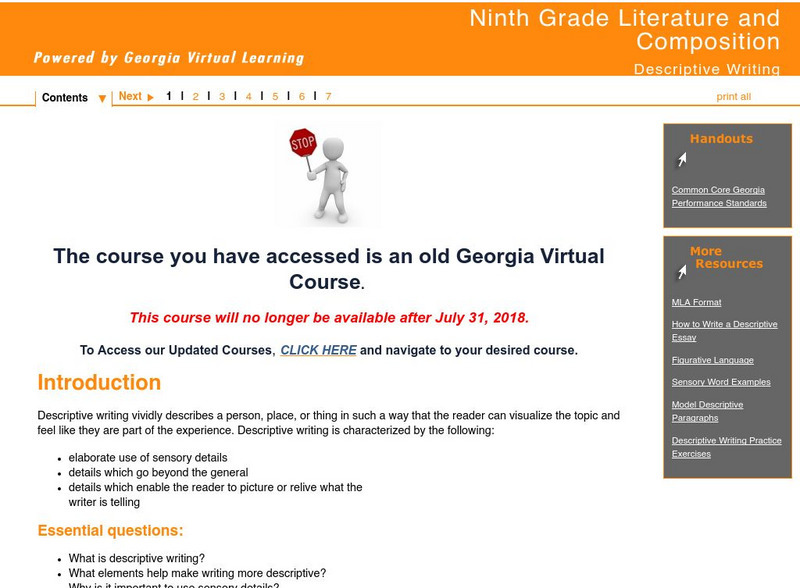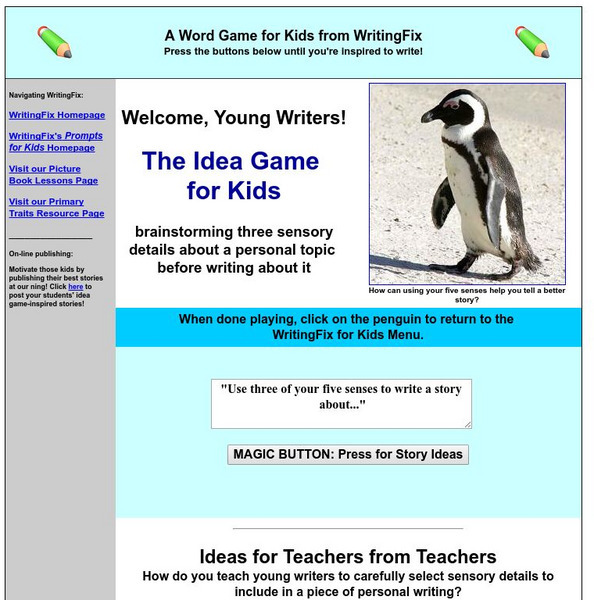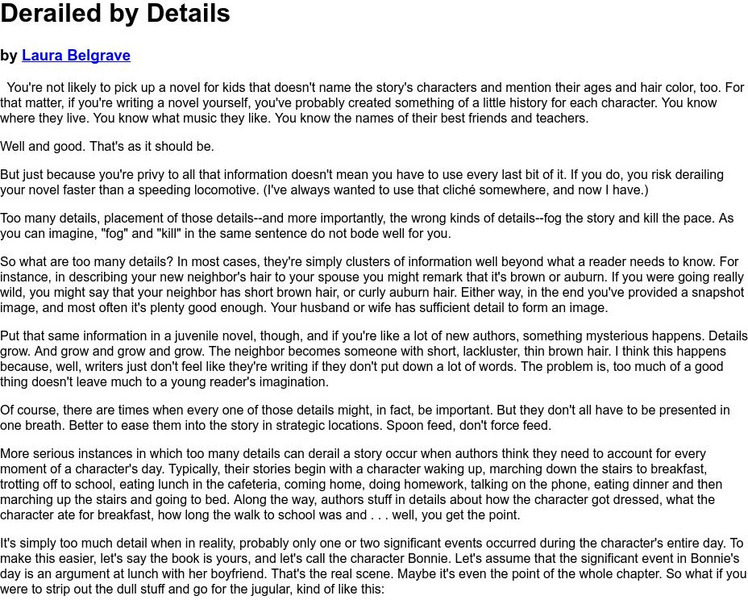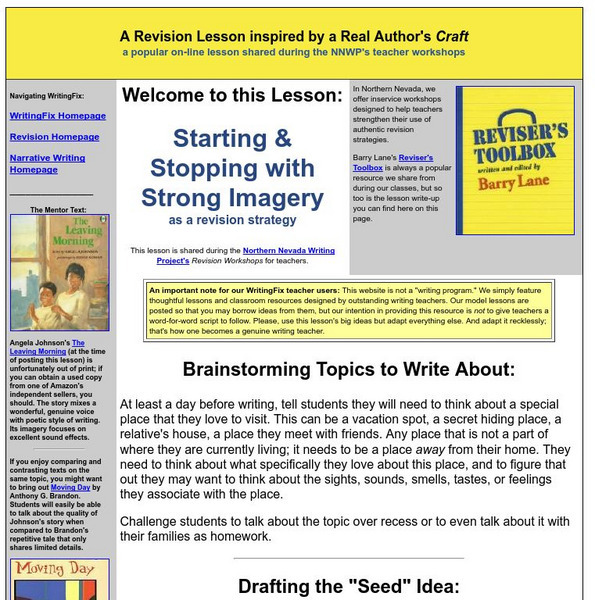Curated OER
Writing with Style: Six Traits of Good Writers
Fourth graders listen as the teacher reads a picture book that emphasized word choice. They discuss words and how word choice impacts a piece of writing. Students view various passages on the overhead, and highlight adjectives and verbs...
Curated OER
Night Hike
Students explore Upham Woods at night and investigate about the special adaptations of nocturnal animals. They identify three nocturnal animals and how they are adapted to the night. Students explain what night vision is and how it works.
Curated OER
Show! Don't Tell!
Students write a descriptive paragraph. For this writing lesson, students define elaboration and discuss the characteristics of an elaborate paragraph. Students write a paragraph that contains vivid adjectives, strong verbs and exact nouns.
Curated OER
Memory of a Kiss
Third graders read, discuss, and memorize the poem "Jenny Kissed Me." as an example of lyrical poetry. They write a letter to Jenny reliving the memory of her kiss from an elderly person's point of view. They illustrate their poems.
Curated OER
Masks from Around the World
Students examine the history of masks, and create their own mask as a culminating activity. They view and discuss a PowerPoint presentation about the history of masks, complete a class KWL chart, create their own mask, and write a...
Curated OER
Five Paragraph Essay
Eighth graders are introduced to the mechanics of writing a standard-form essay. They draft, edit and polish a five-paragraph essay about spending the day as an animal of their choice.
Curated OER
Voyages of Discovery
Young scholars create individual "travel logs" for a world explorer whom they studied in history class. This lesson is an interdisciplinary activity for the Language Arts and History classroom.
Other
Study.com: How to Use Descriptive Details & Sensory Language in Your Writing
When you write a narrative, you can draw your reader into your experiences by adding specific, concrete details and sensory language to your storytelling. This lesson tells you exactly how to do it. W.9-10.3d Precise/sensory details,...
TES Global
Blendspace: Sensory Details
A five-part learning module with links to images and videos about sensory details and using sensory language.
Texas Education Agency
Texas Gateway: Imagery (English Iii Reading)
In this lesson, students will learn how writers use words that allow them to create pictures in their heads. When a writer uses sensory details or words that appeal to our senses, then we are able to use our senses and our memory to...
Alabama Learning Exchange
Alex: Marshmallow and Pretzel Sensory Writing
This language arts lesson plan applies hands-on materials to help students apply the sensory details need for writing. It also incorporates writing skills for comparing and contrasting. In addition, students will utilize Thinkfinity...
Other
Tesol: Sensory Details Worksheet: Adding Details Add Interest
Use this worksheet to practice enhancing your writing by using sensory language. Sensory details include words that describe sights, sounds, and smells of the setting, characters, and interactions.
Texas Education Agency
Texas Gateway: Imagery and Figurative Language (English 7 Reading)
This lesson, focuses on three ways to use figurative language: to create imagery, to appeal to the senses (using sensory detail), and to suggest mood.
Other
Indiana Univerisity of Pennsylvania: Writing Center: Descriptive Writing
This website from the Writing Center at Indiana Univerisity of Pennsylvania focuses on descriptive writing. It includes discussion and examples of the following: Creating a dominant impression or mood, using sensory details, using vivid...
Writing Fix
Writing Fix: The Sum of Its Parts
Inspired by Julianna's understanding (from the novel Flipped by Wendelin Van Draanen) that "A painting is more than the sum of its parts," learners will describe a memorable place that evokes a certain feeling or emotion. Students will...
Georgia Department of Education
Ga Virtual Learning: Ninth Grade Literature and Composition: Descriptive Writing
This lesson focuses on descriptive writing including discussing what it is and the chararacteristics. It provides links to the web articles: "How to Write a Descriptive Essay," "5 Model Descriptive Paragraphs," "MLA Formatting and Style...
The Write Place
Literacy Education Online
Literacy Education Online (or LEO) is a great place to start if you need help with your writing. The homepage is organized around kinds of problems or questions you might have concerning your writing. Find your problem, click on the...
Writing Fix
Writing Fix: A Word Game for Kids: The Idea Game for Kids
How can using your five senses help you tell a better story? Young writers brainstorm three sensory details about a personal topic before writing a story about it. If they need help with ideas, they can click the magic button for story...
Harold D. Underdown
Derailed by Details
A helpful site for writers which gives the proper perspective in assessing the detail involved in your writing. Provides examples of how to include exciting, relevant details when writing fiction.
Alabama Learning Exchange
Alex: Gummy Worm Writing
This activity is designed to introduce descriptive writing. It can be used in grades 3-5. [Requires Adobe Reader.]
Alabama Learning Exchange
Alex: Descriptive Essay
Students learn to use one-main-idea think-sheets when producing simple descriptive essays.
Writing Fix
Writing Fix: Starting & Stopping With Strong Imagery: Revision Strategy
In this lesson, students will engage in revising their writings to incorporate sensory images. Students will brainstorm topics of places, away from their home, that are special. Then students will choose and then write a descriptive...
Alabama Learning Exchange
Alex: 'Nuts' About Peanuts!! (Writing)
This lesson will be implemented as part of a unit about plants. The students will describe the characteristics of a peanut and peanut butter (using their five senses) and record their observations/descriptions on a graphic organizer....
TeachEngineering
Teach Engineering: Hearing: How Do Our Ears Work?
Students learn about the anatomy of the ear and how the ears work as a sound sensor. Ear anatomy parts and structures are explained in detail, as well as how sound is transmitted mechanically and then electrically through them to the...




